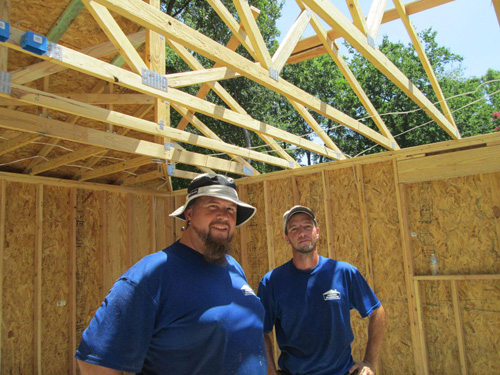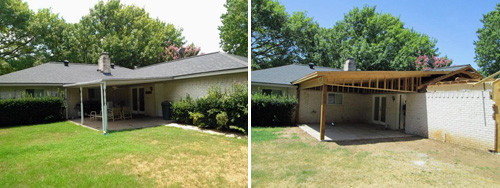
When adding new structures on the outside of your home, or tearing out and remodeling rooms on the inside, having guys like Dave and Neil on hand is a huge plus. These two are highly skilled remodelers. They are master framing and trim carpenters, with above average skills and knowledge in all phases of remodeling, including painting, drywall, tile and light plumbing and electrical.
The framing is well under way on our garage and patio cover project. On the patio cover, you can see the old one was attached to the end of the rafters and was flat, which is a design that is destined to fail. We framed the new roof into the existing roof at a higher point so it can drain properly. The overhang detail will match the existing overhang so it doesn’t look like an add-on. This patio cover will be here as long as the house is standing.
The roof is framed on the new garage, and they are about to install transition rafters. This is a tricky process. The goal is for the roof structures to be seamless in appearance from the outside. The existing roof structure is about 30 years old. Originally, it had wood shingles nailed on 1 x 4 lathing. At some point, the wood shingles were removed, plywood was added to the lathing and shingles on top of that. And, it’s settled some. The plywood on the new structure has to line up perfectly with the old plywood, so each piece of the new structure that is remaining has to be custom cut to make this happen. As I said, it’s great to have Dave and Neil to make this happen.
Another professional skill Dave and Neil have is the ability to work outside in the sun on days like today when the temperatures are nearly 110.
Here are a few tips on how they stay cool:
- Stay hydrated. This means drinking plenty of water before you need it. Here is a well written article on how water works in your body: http://www.valleywater.net/hydration.htm
- Keep your skin covered with moisture-wicking clothing. Technical fabrics have improved significantly in recent years and can help keep you much more comfortable.
- Wear a hat and lay a wet cloth on the back of your neck.
- Know the signs of heat stroke. Dizziness, weakness, confusion, and vomiting are a few.
Be safe!
Mike









